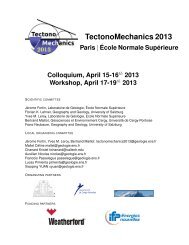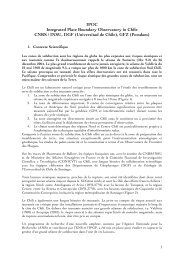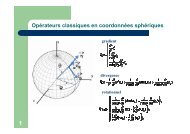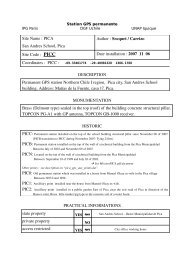PDF file - Laboratoire de Géologie de l'Ecole normale supérieure - Ens
PDF file - Laboratoire de Géologie de l'Ecole normale supérieure - Ens
PDF file - Laboratoire de Géologie de l'Ecole normale supérieure - Ens
Create successful ePaper yourself
Turn your PDF publications into a flip-book with our unique Google optimized e-Paper software.
JOURNAL OF GEOPHYSICAL RESEARCH, VOL. ???, XXXX, DOI:10.1029/,<br />
A Deca<strong>de</strong> of GPS Measurements in S.E. Asia: (Re)Defining Sundaland<br />
Motion and its Boundaries<br />
W.J.F. Simons, 1 A. Socquet, 1 C. Vigny, 2 S. Matheussen, 1 B.A.C. Ambrosius, 1 C.<br />
Subarya, 3 R.W. Matindas, 3 D.A.C. Sarsito, 4 J. Kahar, 4 S. Haji Abu, 5 H. Bin Ali, 5 Chaiwat<br />
Promthong, 6 Phanusak Swangnet, 6 M. Iwakuni, 7 T. Kato, 7 P. Morgan 8 and W. Spakman 9<br />
Abstract. An updated geo<strong>de</strong>tic solution on crustal velocities in S.E. Asia is presented. Parts<br />
of the existing GEODYSSEA network in S.E. Asia were re-measured, and episodical and/or<br />
permanent data from new GPS points in Indonesia, Malaysia, Myanmar and Thailand were<br />
ad<strong>de</strong>d. The expan<strong>de</strong>d GPS database on S.E. Asia now provi<strong>de</strong>s more than 100 velocity estimates<br />
with horizontal accuracies of 0.5-2.5 mm/yr. To achieve this, both the GIPSY GPS<br />
software package and the International Terrestrial Reference Frame solution of 2000 (ITRF-<br />
2000) were used, thereby using improved processing and mapping strategies. Based on 28 velocity<br />
vectors on its rigid part, a refined pole for Sundaland in ITRF-2000 was computed, located<br />
at 48.9ÆSand 85.8ÆE and with a clockwise rotation rate of 0.341Æ/Myr. The Sundaland<br />
block is composed of a rigid core, characterized by very slow strain rates and residual<br />
velocities < 3 mm/yr, which covers the Indochina and Malaysian peninsulas in the North<br />
and West, the Sunda shelf, the major part of Borneo in the East and extends to the South almost<br />
until Java. However, strain rates increase from the core of Sundaland outwards, with significant<br />
<strong>de</strong>formation occurring close to its boundaries. With respect to GPS Eurasia, Sundaland<br />
rotates clockwise at 0.106Æ/Myr around a pole located at 108ÆE, 36ÆS. The predicted Sundaland<br />
/ Eurasia motion confirms an Eastward motion, increasing from south to north, of Sundaland<br />
with respect to Siberia. With respect to South China, the motion is small but significant<br />
and increases from very small values within the South China Sea in the pole area, to<br />
higher strain rates in the Red River area.<br />
1. Introduction<br />
The plate tectonics concept [McKenzie and Parker, 1967; Morgan,<br />
1968; Le Pichon, 1968; Chase, 1972, 1978; Minster and Jordan,<br />
1978] was a fundamental advance in un<strong>de</strong>rstanding global<br />
Earth behavior, however it still lacks in complexity to <strong>de</strong>scribe<br />
continental area’s kinematics and <strong>de</strong>formation. For example, the<br />
NUVEL-1A mo<strong>de</strong>l [DeMets et al., 1990, 1994] presents a global<br />
plate motion mo<strong>de</strong>l, averaged for the last 3 Myrs, based on geological<br />
constraints. For Eurasia, this kinematic mo<strong>de</strong>l predicts a rigid<br />
plate from Western Europe until South-East Asia. However, it was<br />
recognized early that the spectacular Asiatic relief pattern attests for<br />
intra-continental <strong>de</strong>formation extending from the Himalayas to the<br />
Baikal rift zone to the North, and until the Red River Fault in the<br />
South East, resulting from the collision between India and Eurasia<br />
[Argand, 1924].<br />
Deformation of Asia has been extensively studied from the 70’s by<br />
Department of Earth Observation and Space Systems (DEOS),<br />
Delft University of Technology, Delft, The Netherlands<br />
École Normale Supérieure (ENS), Paris, France<br />
National Coordination Agency for Surveys and Mapping<br />
(BAKOSURTANAL), Cibinong, Indonesia<br />
Institute of Technology Bandung (ITB), Bandung, Indonesia<br />
Department of Survey and Mapping Malaysia (DSMM), Kuala<br />
Lumpur, Malaysia<br />
Royal Thai Survey Department (RTSD), Bangkok, Thailand<br />
Earthquake Research Institute, University of Tokyo, Tokyo, Japan<br />
University of Canberra (UC), School of Computing, Canberra,<br />
Australia<br />
Faculty of Earth Sciences, University of Utrecht, Utrecht, The<br />
Netherlands<br />
Copyright 2004 by the American Geophysical Union.<br />
0148-0227/04/$9.00<br />
1<br />
analysis of satellite imagery [Tapponnier and Molnar, 1977, 1979],<br />
geological and seismological studies [Molnar and Tapponnier,<br />
1978; Molnar and Lyon-Caen, 1989]. To explain the geological<br />
features and the geophysical data set, end-members mo<strong>de</strong>ls assume<br />
that continents <strong>de</strong>form either by viscous flow of a continuously<br />
<strong>de</strong>forming medium [England and Houseman, 1985, 1986; Houseman<br />
and England, 1986, 1993] or by motion of rigid lithospheric<br />
blocks along narrow fault zones [Tapponnier et al., 1982; Tapponnier,<br />
1986; Peltzer and Tapponnier, 1988; Avouac and Tapponnier,<br />
1993; Peltzer and Saucier, 1996; Meyer et al., 1998]. Discriminating<br />
these end-members mo<strong>de</strong>ls requires spatially <strong>de</strong>nse measurements<br />
of surface strain rate. High accuracy GPS measurements can<br />
constrain mo<strong>de</strong>ls for a better un<strong>de</strong>rstanding of the mo<strong>de</strong> of <strong>de</strong>formation<br />
of the lithosphere and of the plates kinematics.<br />
The Sundaland block, making up a large part of South-East Asia,<br />
has been the subject of discussions whether or not it has a significant<br />
motion with respect to the Eurasian plate and how the <strong>de</strong>formation<br />
is distributed between Siberia and South-East Asia.<br />
Initial GPS results in S.E. Asia (eg. [Tregoning et al., 1994; Genrich<br />
et al., 1996]) let to the conclusion that this region seemed rigidly<br />
connected to the Eurasian plate. However, this conclusion was obtained<br />
from using mostly local GPS data, many of which are located<br />
in <strong>de</strong>formation zones (Sumatra, Java, Sulawesi, Banda Arc)<br />
and hence not belong anymore to rigid Sundaland. Later, the results<br />
of the GEODYSSEA project [Wilson et al., 1998; Chamot-Rooke<br />
et al., 1998; Simons et al., 1999; Michel et al., 2001] showed clearly<br />
that the Sundaland block presents a rigid motion with respect to<br />
Eurasia and is separated from the Siberian platform through a series<br />
of <strong>de</strong>forming and moving blocks, invalidating by the way the<br />
NUVEL-1A mo<strong>de</strong>l [DeMets et al., 1994] for present-day <strong>de</strong>formation.<br />
This project, led between 1994 and 1998, used a GPS network<br />
systematically distributed over Sundaland, which is most suited to<br />
accurately <strong>de</strong>termine a rigid plate motion.<br />
Since then, the GPS database on South-East Asia has been expan<strong>de</strong>d<br />
by including new high-quality GPS measurements of both<br />
episodically and continuously operated sites. Besi<strong>de</strong>s actively carrying<br />
out GPS surveys through international cooperation, this was






